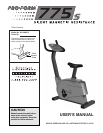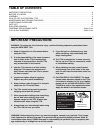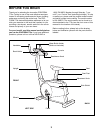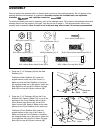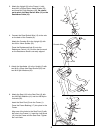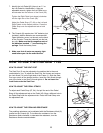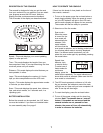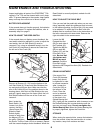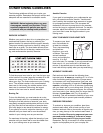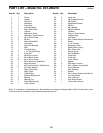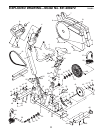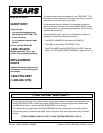
9
CONDITIONING GUIDELINES
The following guidelines will help you to plan your
exercise program. Remember that proper nutrition and
adequate rest are essential for successful results.
EXERCISE INTENSITY
Whether your goal is to burn fat or to strengthen your
cardiovascular system, the key to achieving the
desired results is to exercise with the proper intensity.
The proper intensity level can be found by using your
heart rate as a guide. The chart below shows recom-
mended heart rates for fat burning, maximum fat burn-
ing, and cardiovascular (aerobic) exercise.
To find the proper heart rate for you, first find your age
at the bottom of the chart (ages are rounded off to the
nearest ten years). Next, find the three numbers
above your age. The three numbers are your Òtraining
zone.Ó The smallest number is the recommended
heart rate for fat burning; the middle number is the
heart rate for maximum fat burning; the largest
number is the heart rate for aerobic exercise.
Burning Fat
To burn fat effectively, you must exercise at a rela-
tively low intensity level for a sustained period of time.
During the first few minutes of exercise, your body
uses easily accessible carbohydrate calories for ener-
gy. Only after the first few minutes of exercise does
your body begin to use stored fat calories for energy.
If your goal is to burn fat, adjust the intensity of your
exercise until your heart rate is near the smallest
number in your training zone as you exercise.
For maximum fat burning, adjust the intensity of your
exercise until your heart rate is near the middle num-
ber in your training zone as you exercise.
Aerobic Exercise
If your goal is to strengthen your cardiovascular sys-
tem, your exercise must be Òaerobic.Ó Aerobic exer-
cise is activity that requires large amounts of oxygen
for prolonged periods of time. This increases the
demand on the heart to pump blood to the muscles,
and on the lungs to oxygenate the blood. For aerobic
exercise, adjust the intensity of your exercise until
your heart rate is near the largest number in your
training zone.
HOW TO MEASURE YOUR HEART RATE
To measure your heart
rate, first exercise for
at least four minutes.
Then, stop exercising
and place two
fingers on your wrist
as shown. Take a six-
second heartbeat
count, and multiply the
result by 10 to find
your heart rate. For example, if your six-second heart-
beat count is 14, your heart rate is 140 beats per
minute. (A six-second count is used because your
heart rate will drop rapidly when you stop exercising.)
WORKOUT GUIDELINES
Each workout should include the following three
important parts: A warm-up, consisting of 5 to 10 min-
utes of stretching and light exercise. A proper warm-
up increases your body temperature, heart rate, and
circulation in preparation for exercise. Training zone
exercise, consisting of 20 to 30 minutes of exercising
with your heart rate in your training zone. (During the
first few weeks of your exercise program, do not keep
your heart rate in your training zone for longer than 20
minutes.) A cool-down, with 5 to 10 minutes of
stretching. This will increase the flexibility of your mus-
cles and will help to prevent post-exercise problems.
EXERCISE FREQUENCY
To maintain or improve your condition, plan three
workouts each week, with at least one day of rest
between workouts. After a few months of regular exer-
cise, you may plan up to five workouts each week, if
desired. Caution: Be sure to progress at your own
pace and avoid overdoing it. Incorrect or exces-
sive training may result in injury to your health.
Remember, the key to success is to make exercise a
regular and enjoyable part of your everyday life.
WARNING: Before beginning this or any exer-
cise program, consult your physician. This is
especially important for persons over age 35
or persons with pre-existing health problems.



